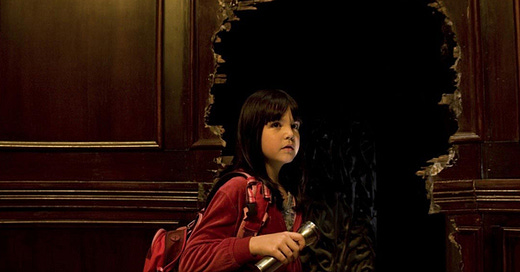Don't Be Afraid of the Dark

Despite two good performances, stylish set design and relative restraint, “Don’t Be Afraid of the Dark” gets stuck in the negative space between “creepy” and “scary.”
Director Troy Nixey’s film never goes all in on the terror it purports to peddle in the film’s finale. Nor does it fulfill the promise of devil’s-dance playfulness suggested by composers Marco Beltrami and Buck Sanders’ fiddle-riddled opening fanfare.
It’s got a few jostling jolts, but it’s easily the most middling movie to which Guillermo del Toro (co-writing and producing) has attached his name since “Mimic.” Plus, as the softest R-rated movie in years — with no more gore than any given night of CBS programming — it continues to make the MPAA increasingly irrelevant.
Speaking of television, del Toro and co-writer Matthew Robbins rewrite a 1973 TV movie renowned for what, back then, must have been a shocking conclusion. They’ve added 25 minutes and kept the protagonist female, but they’ve made her a little girl — echoes of del Toro’s own “Pan’s Labyrinth” in a far less imaginative film.
Sally (Bailee Madison) has been cast off by a prescription-happy mother and shipped to Rhode Island to live with her father, Alex (Guy Pearce). He’s a professional home renovator who’s sunken his savings into the Blackwood estate.
Mr. Blackwood — whom we’ve met in a dentally gruesome, Lovecraftian prologue — was a renowned artist. The national attention from a beautiful restoration of his home is what Alex needs to “get his career back” (although we never learn how he lost it).
Also in the mix is Kim (Katie Holmes), an interior designer and Alex’s girlfriend who fancies herself a Blackwood scholar but not at all a surrogate mother.
Holmes again turns in a nuanced performance in a thriller few people are likely to see (“Abandon,” “The Gift”). And Madison sells Sally’s fright at becoming freight in a failed family with one heartbreaking scene of quiet sobbing.
But this moppet excels at more than crying on cue. She brings to the role the same raw power she did in 2009’s “Brothers” and exudes the idea that Sally is a susceptible soul — one with enough curiosity, weakness … and teeth to feed the creatures in the basement.
Whispering promises of eternal playtime and friendship through the vents, the creatures convince Sally to free them from their subterranean cell. What she doesn’t know is that even if she chooses not to join them, they’ll try to take her by force.
In “Dark’s” early moments, the air is alive and ominous with dread — the demons seemingly as likely to descend upon Sally in daylight as in the darkness. That’s why it’s a bit of a downer when, once the gremlins go on the loose, “Dark” pulls out the dog-eared haunted-house playbook out of its back pocket and disappoints with the creatures’ reveal.
Blame Kim’s shredded clothes on petulant Sally? Show no suspicion after a helpful handyman is mutilated in the basement? Insist beyond reason that this is all in Sally’s head? Check, check and check.
Subtle suggestions of a Brothers Grimm variation on the Tooth Fairy legend offer the occasional respite. But once del Toro and Robbins ladle thick, fat expositional gravy over that, it’s just another heavy ingredient to the film’s overcooked second course. (Plus, this insists that Kim, a supposed expert on all things Blackwood, would know nothing about his late, clearly disturbed period of artwork.)
As to the monstrous baddies, they’re better seen in fits and starts as they skitter from the light like cockroaches. A curator of so many classic creatures, del Toro whiffs here. The tiny goblins resemble biped bats that have replaced their wings with legs — hairy hunchbacks who look like a higher-budgeted cousin to the imps from 1987’s B-horror staple “The Gate.”
One sudden POV shift gives the gut an unexpected loop-de-loop. The creatures’ use of small spaces and objects to generate menace makes for a couple of clever compositions. And the conclusion’s grim irony is worth an appreciative smirk.
But those piecemeal treats are the problem with “Don’t Be Afraid of the Dark.” They never add up to a cumulative chill. Honestly, the most frightening thing it has to offer is the use of Comic Sans in its end credits.


